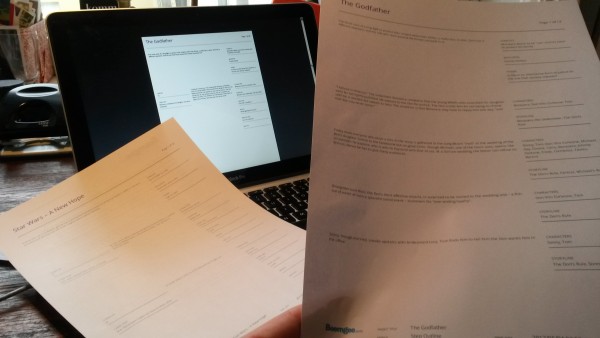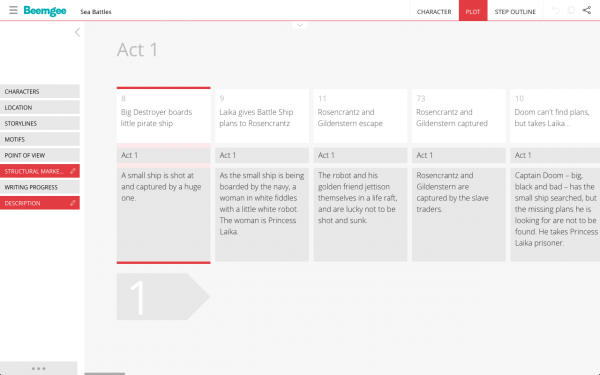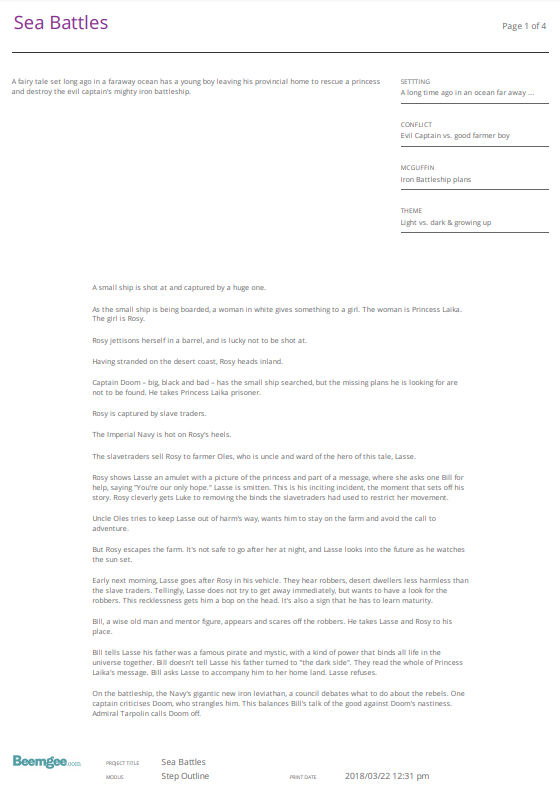Step Outline
The step outline is the scene by scene (step by step) account of what happens in the story.
Like a textual storyboard, the step outline presents the narrative in its entirety – without actually being the narrative. It is a complete report of the story – in the present tense! – that describes every plot event.
Cause and Effect
The step outline therefore makes one of the most important principles of storytelling very clear, cause and effect.
Apart from the kick-off event and the closing event, every plot event fulfils two functions, at least to an extent:
- It is a precondition of events that follow it in the narrative
- It is an inevitable consequence of events that have preceded it in the narrative
The step outline should make it easier to understand how the individual events relate to each other in this chain of cause and effect. The step outline may thus be read as the author’s construction plan of the narrative. Because it is in the form of continuous text, this version of the plan makes it easier for other people, such as editors or producers, to understand the construction the author intends than, for example, note cards stuck to a wall.
The Use of the Step Outline
The cards on a wall (or in the Beemgee plot outlining tool), which each bear a short title or designation of an event, help the author understand how the plot works. The step outline introduces the plot to another party. The text description helps this person to understand the construction principle – and gives them the knowledge necessary to understand what event the designation on each card stands for.
Once they know that, they can work on the plot outline too, for instance by shifting the order of the cards or making suggestions for further plot events.
But it is most likely that an author will use the step outline to pitch a project.

As an introduction to a story project, the step outline is likely to be too detailed. In the very first instance, an author will probably need just one sentence which describes the story as accurately as possible. This sentence is the logline.
Other Text Types that Describe a Story Proposal: Logline, Exposé, Synopsis, Treatment
The logline is the most condensed description of the story. The entire story is made to fit in one sentence. The logline gets people interested in the story. Creating it – and rewording it again and again – is a good exercise for authors because it helps them get to know the material and find its essence. It is so important that in the Beemgee web-app we have included it as a supplement to the STEP OUTLINE feature.
In the exposé, the entire work is made to fit on one page as a brief proposal, for instance for publishers. Only one or two paragraphs on this page describe the story as a summary of what happens. The rest of the space is dedicated essentially to sales information about the author, including previous works, the author’s assessment of the target group, comparable stories and competitive titles, etc.
A synopsis, especially for filmmakers, is a one to three page description of the story which includes the author’s bigger picture intentions. This is often demanded by producers or film funds and allows them to understand the themes of the story as well as the author’s motivation for wanting to tell it.
In a treatment, the plot is given enough space that it mentions each main character and storyline, as well as the design principle of the narrative. The treatment is longer than a summary but shorter than the scene by scene step outline. It must contain the ending – never present an industry professional a treatment that does not describe the outcome of the story for fear of spoiling it.
The Beemgee Step Outline
In Beemgee, the STEP OUTLINE feature is connected to the DESCRIPTIONs function.
 Click the project image to open this sample project.
Click the project image to open this sample project.
Clicking STEP OUTLINE shows all DESCRIPTIONs in the narrative sort order as editable copy text.
In PREMIUM, a detail view is included that shows all the information you have attributed to each plot event card. Furthermore, PREMIUM includes some important questions concerning the entire story, including space for your logline. The exportable Step Outline looks like this (story questions included, plot attributes hidden):
Click the project image to open this sample project.
Related functions in the Beemgee story development tool:
Step Outline and Pitch/Proposal
Find out more about the Beemgee author tool in this brief video:
To create your own new story project, click this button:


